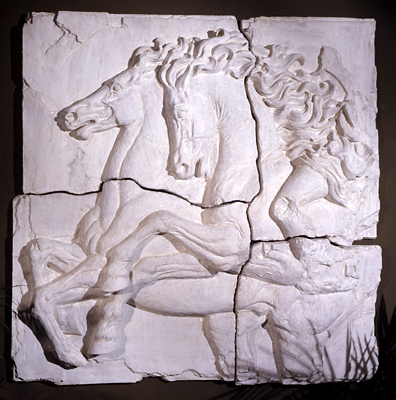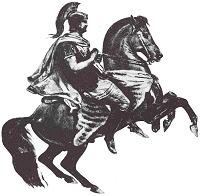
The Road Not Taken II
"Theory instructs us that we should work from a foundation of sound principles, and these principles, rather than going against nature, must serve to protect it with the aid of art...." Francois Robichon de la Guérinière
That summer, I started Ojo anew. Karen had introduced me to ground training principles, essentially reining principles, unused by the Natural Horsemanship practitioners I was familiar with. Those first sessions with him were challenging and frustrating. I was struggling with my delivery, and he couldn’t read my mind. Thankfully, he was patient, I was patient, and neither of us lost our temper with each other. We just kept trying, and as time passed, the delivery became less awkward and more effective.
The mounted work offered a different kind of challenge. These novel principles were directly opposite of the way he had been trained to respond to leg aids. Instead of going forward off a kick, or turning right with left leg pressure, I asked him to step into the opening of a forward movement, and turn right into a space created by my open right leg. I was extinguishing the “sending away” cues, and replacing them with “drawing in” cues. I had a new vision for our riding, and a handful of principles to guide me. It was a good start, but it wasn’t enough. That’s when Craig Stevens entered the picture.
"In the riding school he practices the correct execution but this knowledge needs to be cultivated by books and benevolent interpretations. The rider who by acknowledging this has acquired real insight into the subject has reached a level incomparable to a rider who only has practical or the first way of skill. They also differ widely when it comes to their ability as instructors. The later one will produce a poor result as an instructor, and this is especially the case if he does not seek to avoid any kind of charlatanry. If this rider on the other hand has any real artistic sense (virtuosity), we must appreciate him only for this rare natural gift that gives him the necessary technical skill.” Ehrengranat, 1836
That summer, I started Ojo anew. Karen had introduced me to ground training principles, essentially reining principles, unused by the Natural Horsemanship practitioners I was familiar with. Those first sessions with him were challenging and frustrating. I was struggling with my delivery, and he couldn’t read my mind. Thankfully, he was patient, I was patient, and neither of us lost our temper with each other. We just kept trying, and as time passed, the delivery became less awkward and more effective.
The mounted work offered a different kind of challenge. These novel principles were directly opposite of the way he had been trained to respond to leg aids. Instead of going forward off a kick, or turning right with left leg pressure, I asked him to step into the opening of a forward movement, and turn right into a space created by my open right leg. I was extinguishing the “sending away” cues, and replacing them with “drawing in” cues. I had a new vision for our riding, and a handful of principles to guide me. It was a good start, but it wasn’t enough. That’s when Craig Stevens entered the picture.
"In the riding school he practices the correct execution but this knowledge needs to be cultivated by books and benevolent interpretations. The rider who by acknowledging this has acquired real insight into the subject has reached a level incomparable to a rider who only has practical or the first way of skill. They also differ widely when it comes to their ability as instructors. The later one will produce a poor result as an instructor, and this is especially the case if he does not seek to avoid any kind of charlatanry. If this rider on the other hand has any real artistic sense (virtuosity), we must appreciate him only for this rare natural gift that gives him the necessary technical skill.” Ehrengranat, 1836

Craig introduced me to a body of literature I had not known existed. On Horsemanship by Xenophon is considered the earliest treatise on horsemanship and dates 350 BC, and horsemen authors who followed him include Antoine de Pluvinel , William Cavendish, Francois Robichon de la Guérinière, Dupaty de Clam, Francois Baucher, Gen. Alexis L’Hotte, Cpt. Etienne Beudant, Adam Ehrengranat , Jean Licart , Rene Bacharach, and Nuno Oliveira, to name a few. These are but a handful of the world’s most respected master horsemen, and although deceased, their work lives on in their students and in their written work. Technical skill and experience with horses is important, but access to the
master’s work facilitates an understanding that goes beyond theory, even beyond practice. Access to and understanding of these natural principles gives breath, life, vitality, dimension and immortality to the art of horsemanship.
“One calls an “Ecuyer“, a man who can train a horse to be controlled with grace and accuracy, and who is able to form a true horseman…The metamorphosis from the “solid and skillful rider” to an Ecuyer is indeed an operation which falls more on the student than with the Master, General L’Hotte has explained this point extremely well in his “Equestrian Questions”. Rene Bacharach
It is said, when the student is ready, the teacher will appear. Teachers can be light posts and street markers, guiding our way, keeping the map. The road of life is filled with twists and turns, and can lead us to places we didn’t expect to be. Fortunately, humans, like horses, are highly adaptable creatures. Ojo has been re-started in three different ways, a new method applied each year as a three, four and five year old. He has taught me that a willing student is capable of anything that can be imagined. He is my student, and my teacher, and I am inspired daily by his willingness, patience and grace.
My own path has taken some twists and turns, and I currently find myself at a fork in the road. The road I am choosing will take me away from you, readers, but I hope the articles of the past several weeks have served to inspire, illuminate, and guide you on your horsemanship journey. Your abilities and skills know only the bounds of your imagination and perseverance. May you be blessed with an abundance of each of these things, as you make your way down your road.
“One calls an “Ecuyer“, a man who can train a horse to be controlled with grace and accuracy, and who is able to form a true horseman…The metamorphosis from the “solid and skillful rider” to an Ecuyer is indeed an operation which falls more on the student than with the Master, General L’Hotte has explained this point extremely well in his “Equestrian Questions”. Rene Bacharach
It is said, when the student is ready, the teacher will appear. Teachers can be light posts and street markers, guiding our way, keeping the map. The road of life is filled with twists and turns, and can lead us to places we didn’t expect to be. Fortunately, humans, like horses, are highly adaptable creatures. Ojo has been re-started in three different ways, a new method applied each year as a three, four and five year old. He has taught me that a willing student is capable of anything that can be imagined. He is my student, and my teacher, and I am inspired daily by his willingness, patience and grace.
My own path has taken some twists and turns, and I currently find myself at a fork in the road. The road I am choosing will take me away from you, readers, but I hope the articles of the past several weeks have served to inspire, illuminate, and guide you on your horsemanship journey. Your abilities and skills know only the bounds of your imagination and perseverance. May you be blessed with an abundance of each of these things, as you make your way down your road.
6.1.12 TME
Return to Educated Equestrian
Return to Educated Equestrian